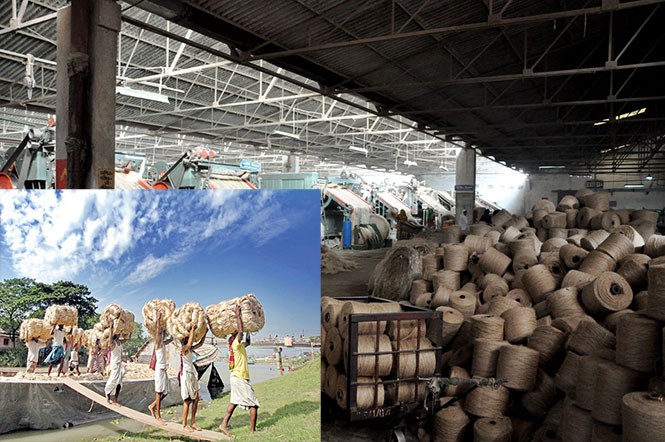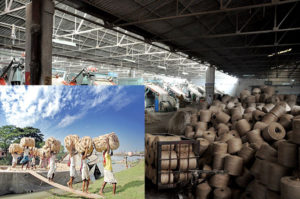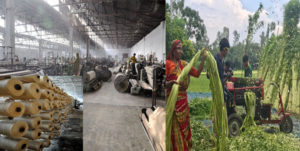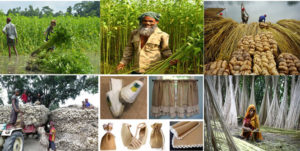
 Desk Report: Bangladeshi jute is well known as Golden Fiber of Bangladesh. But it lost its golden color day by day. Eight years after decoding the jute genome, Bangladeshi scientists have come up with a highly productive new variety, with finer and stronger fiber, and brighter texture of this Golden Fiber.
The success of Bangladeshi scientists in decoding the genome map of the jute plant has finally started yielding results in terms of new varietal development.
By triggering expression of a gene in jute plants, scientists at the Bangladesh Jute Research Institute (BJRI) have successfully developed a new variety, which has a 20 percent higher yield potential, finer and stronger fiber quality, and can be planted early in the season, thereby freeing up land seasonally for rice cultivation.
The National Seed Board released the promising jute variety - BJRI Tossa-8 (also known as Robi-1) - the first variety derived through enhancing the expression of a specific gene responsible for fiber formation in jute plants.
BJRI Director General, Dr. Md. Monjurul Alam, told that Robi-1 has 20 percent more yield potential, compared to the hitherto best Bangladeshi Tossa variety, BJRI Tossa-2. The new variety was field tested in 12 different locations across the country and its yield was found to be 3.33 tons a hectare, compared to BJRI Tossa-2’s 2.77 tons.
Desk Report: Bangladeshi jute is well known as Golden Fiber of Bangladesh. But it lost its golden color day by day. Eight years after decoding the jute genome, Bangladeshi scientists have come up with a highly productive new variety, with finer and stronger fiber, and brighter texture of this Golden Fiber.
The success of Bangladeshi scientists in decoding the genome map of the jute plant has finally started yielding results in terms of new varietal development.
By triggering expression of a gene in jute plants, scientists at the Bangladesh Jute Research Institute (BJRI) have successfully developed a new variety, which has a 20 percent higher yield potential, finer and stronger fiber quality, and can be planted early in the season, thereby freeing up land seasonally for rice cultivation.
The National Seed Board released the promising jute variety - BJRI Tossa-8 (also known as Robi-1) - the first variety derived through enhancing the expression of a specific gene responsible for fiber formation in jute plants.
BJRI Director General, Dr. Md. Monjurul Alam, told that Robi-1 has 20 percent more yield potential, compared to the hitherto best Bangladeshi Tossa variety, BJRI Tossa-2. The new variety was field tested in 12 different locations across the country and its yield was found to be 3.33 tons a hectare, compared to BJRI Tossa-2’s 2.77 tons. “One of the other great features is, the new jute variety can be planted far in advance, compared to other Tossa varieties and thereby, jute growers would not miss out on the prime Aman rice season,” explained Dr Alam.
By taking advantage of knowledge gained from jute’s gene mapping, the jute specialists are now also in an advanced stage of developing at least three more new varieties, having different key traits, which will help Bangladesh offer the world a better quality natural fiber.
In 2010, internationally acclaimed Bangladeshi scientist Maqsudul Alam and his team members that included, among others, Dr. Md. Monjurul Alam, successfully decoded the jute plant genome, opening up a new vista in the development of varieties of the world's most adored biodegradable natural fiber.
Experts had said then that the development (gene sequencing) would help improve fiber length and quality, including colors and strength, and develop high yielding, saline, and pest-tolerant jute varieties through genetic engineering.
“One of the other great features is, the new jute variety can be planted far in advance, compared to other Tossa varieties and thereby, jute growers would not miss out on the prime Aman rice season,” explained Dr Alam.
By taking advantage of knowledge gained from jute’s gene mapping, the jute specialists are now also in an advanced stage of developing at least three more new varieties, having different key traits, which will help Bangladesh offer the world a better quality natural fiber.
In 2010, internationally acclaimed Bangladeshi scientist Maqsudul Alam and his team members that included, among others, Dr. Md. Monjurul Alam, successfully decoded the jute plant genome, opening up a new vista in the development of varieties of the world's most adored biodegradable natural fiber.
Experts had said then that the development (gene sequencing) would help improve fiber length and quality, including colors and strength, and develop high yielding, saline, and pest-tolerant jute varieties through genetic engineering. Maqsudul Alam, who served as a professor of the University of Hawaii, and had earlier decoded the Papaya genome in the US and the rubber plant in Malaysia, led from the forefront in sequencing the jute genome. After his death, Dr. Md. Monjurul Alam, carried forward the research work on varietal developments and finally success came their way.
Jute is the second largest fiber crop, in terms of cultivation, after cotton. Bangladesh is the world's second-largest producer of jute, after India, and the world's largest exporter of the fiber.
BJRI scientists told that the new jute variety would produce finer and stronger fibers with brighter texture compared to other jute varieties now being grown in the country.
They expect that farmers would be able to derive quality jute seed from the new Robi-1 variety and it will eventually decrease Bangladesh’s dependence on India for quality jute seeds.
Maqsudul Alam, who served as a professor of the University of Hawaii, and had earlier decoded the Papaya genome in the US and the rubber plant in Malaysia, led from the forefront in sequencing the jute genome. After his death, Dr. Md. Monjurul Alam, carried forward the research work on varietal developments and finally success came their way.
Jute is the second largest fiber crop, in terms of cultivation, after cotton. Bangladesh is the world's second-largest producer of jute, after India, and the world's largest exporter of the fiber.
BJRI scientists told that the new jute variety would produce finer and stronger fibers with brighter texture compared to other jute varieties now being grown in the country.
They expect that farmers would be able to derive quality jute seed from the new Robi-1 variety and it will eventually decrease Bangladesh’s dependence on India for quality jute seeds. Currently, 85 percent of Bangladesh’s yearly jute fiber output comes from Tossa Jute and the remaining 15 percent from White Jute. Roughly some 5,000 tons of jute seeds are imported to Bangladesh from India a year.
There is no doubt that the jute sector can offer much to the Bangladesh economy, and, as a product, it has much to contribute in helping Bangladesh grow and achieve its economic goals.
Therefore, it is good to see that there is growing enthusiasm among jute farmers, especially in the northern regions of the country like Rajshahi -- this is a result of farmers receiving fairer prices during the last couple of years, encouraging them to cultivate more of the golden fiber.
Indeed, what must be commended is the role private jute mills have played, along with the increased prioritization jute has received from the authorities involved such as favorable bank loans, all of which has created a favorable climate for the farmers to focus their energy on achieving substantial yield.
Currently, 85 percent of Bangladesh’s yearly jute fiber output comes from Tossa Jute and the remaining 15 percent from White Jute. Roughly some 5,000 tons of jute seeds are imported to Bangladesh from India a year.
There is no doubt that the jute sector can offer much to the Bangladesh economy, and, as a product, it has much to contribute in helping Bangladesh grow and achieve its economic goals.
Therefore, it is good to see that there is growing enthusiasm among jute farmers, especially in the northern regions of the country like Rajshahi -- this is a result of farmers receiving fairer prices during the last couple of years, encouraging them to cultivate more of the golden fiber.
Indeed, what must be commended is the role private jute mills have played, along with the increased prioritization jute has received from the authorities involved such as favorable bank loans, all of which has created a favorable climate for the farmers to focus their energy on achieving substantial yield. When it comes to jute cultivation, what cannot be ignored is the vital role technological advancement has also played -- from better quality seeds to using seeder machines and the ribbon-retting method to extract quality fiber, it is extremely encouraging to see our farmers adopting the latest technology in their farming and cultivating efforts.
Jute has historically been of significance to the region -- though the sector has unfortunately received quite a few blows since Bangladesh’s independence in 1971 -- and therefore, it is a step in the right direction to see the authorities take a pro-active approach to reviving the industry and harness its full potential, a decision that no doubt will benefit all of Bangladesh.
Source: Online
KMS/SZK
When it comes to jute cultivation, what cannot be ignored is the vital role technological advancement has also played -- from better quality seeds to using seeder machines and the ribbon-retting method to extract quality fiber, it is extremely encouraging to see our farmers adopting the latest technology in their farming and cultivating efforts.
Jute has historically been of significance to the region -- though the sector has unfortunately received quite a few blows since Bangladesh’s independence in 1971 -- and therefore, it is a step in the right direction to see the authorities take a pro-active approach to reviving the industry and harness its full potential, a decision that no doubt will benefit all of Bangladesh.
Source: Online
KMS/SZK
Comment Now